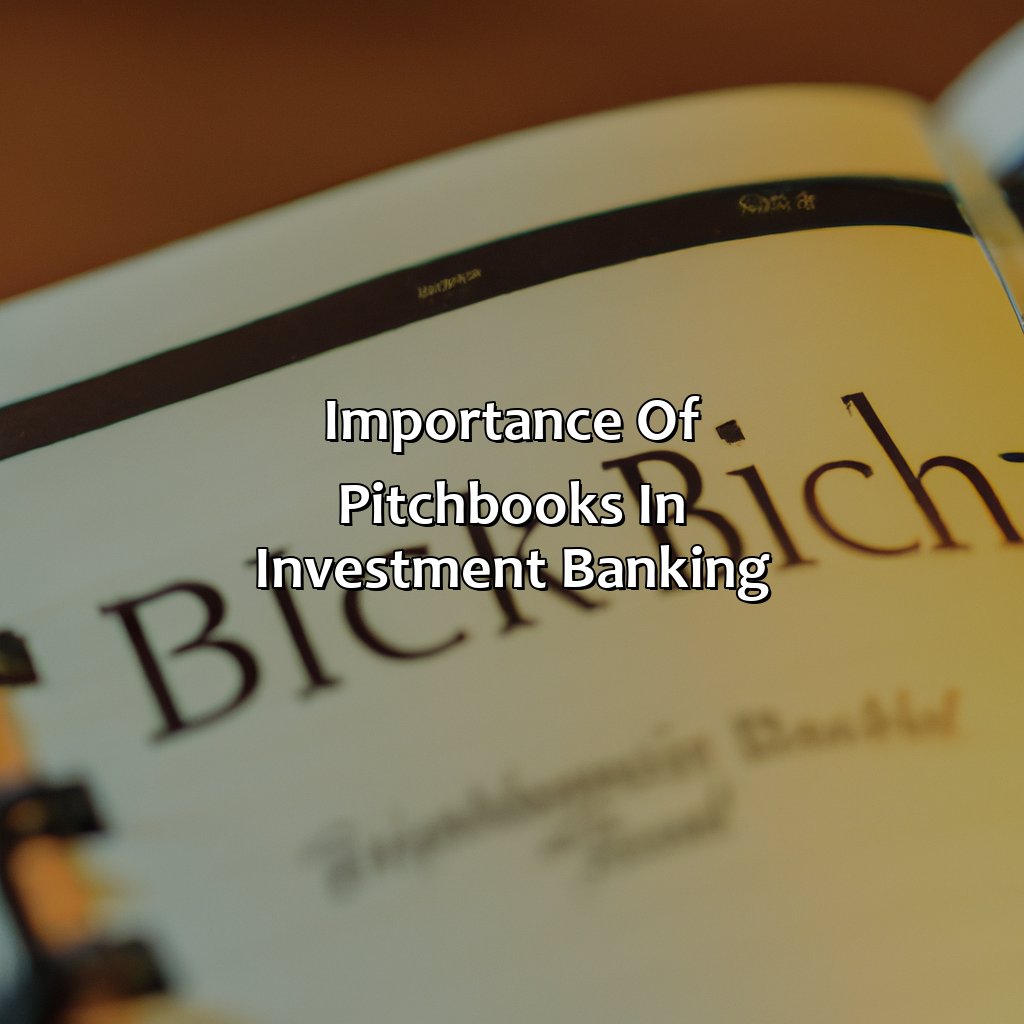What Is A Pitchbook In Investment Banking?
Key Takeaway:
- Pitchbooks are a crucial tool in investment banking that help banks secure deals with clients by presenting a comprehensive overview of the proposed transaction, including company and market analysis, financial projections, and investment considerations.
- The components of a pitchbook typically include a cover page and table of contents, company and market overviews, transaction description, financial analysis, deal structure and valuation, and investment considerations.
- There are two main types of pitchbooks: buy-side and sell-side. Buy-side pitchbooks are used to pitch investment opportunities to potential investors, while sell-side pitchbooks are used to pitch the sale of a company or asset to potential buyers.
Have you ever been curious about the world of investment banking, and what a pitchbook is? This insightful article will provide a comprehensive overview of this important tool, and the role it plays in the financial services industry. You’ll also discover why a pitchbook is an essential component of any successful investment banking venture.
Components of a Pitchbook
Components of a pitchbook? A must-know for investment banking!
- Cover Page
- Table of Contents
- Company Overview
- Market Overview
- Transaction Description
- Financial Analysis
- Deal Structure
- Valuation and Investment Considerations
All these sections have important info to convince investors or clients to invest in the deal.

Image credits: retiregenz.com by David Jones
Cover Page and Table of Contents
On the opening page of a Pitchbook, there is an important section called the Introductory Section. This section serves as the cover page and includes information about the deal, key players, and a table of contents. The table of contents is used to provide an outline of what will be discussed in the book.
The cover page and table of contents are crucial elements in a Pitchbook. It allows potential clients to easily navigate through the pages and understand what is being presented to them. Below is an example of how this section could look.
| # | Section |
|---|---|
| 1 | Cover |
| 2 | Table of Contents |
| 3 | Executive Summary |
| 4 | Market Overview |
It’s important to note that different investment banks may have slightly altered formats for their table of contents. However, it will generally contain similar pieces of information such as the main sections included within the Pitchbook.
A unique aspect about creating this section is that it should be visually appealing but also professional looking. While creativity can be an important factor when designing a cover page, one should avoid appearing too gimmicky or overdone as this may detract from the content inside.
To create an effective table of contents, consider tailoring its structure based on how your firm structures other internal documents. It’s essential to include strong titles that grab readers’ interest while still clearly explaining what each section will entail.
Overall, by approaching this part with both design principles and transparency in mind, creating a successful pitchbook begins on its first few pages with a well designed and informative cover page and table of contents.
Get ready for a company overview that even your ex couldn’t provide.
Company Overview
A comprehensive review of the company’s structure, management, operations and financial performance is provided in this section. This includes a breakdown of the different business units, revenue streams and key partnerships. It is typically presented as an overview of the entire organization, providing potential investors with a snapshot of its strengths and capabilities.
The company overview also highlights the unique value proposition of the organization and its competitive positioning in the market. This information is critical for investors who are looking to understand how the company stands out from other industry players.
Moreover, it sheds light on important milestones achieved by the organization such as mergers and acquisitions, partnerships formed or any significant changes to its business model or operations.
One notable true history surrounding this topic was when Lehman Brothers’ pitchbook during its 2008 bankruptcy disclosure consisted mostly of descriptions and opinions that were both optimistic about Lehman’s future prospects, but concealments about Lehman Brothers’ exposure to real estate assets laid bare in ensuing months.
A market overview is like a Tinder bio for investors – it’s all about presenting your best assets and hoping for a match made in banking heaven.
Market Overview
Understanding the investment landscape is a crucial piece of information for any investor or analyst. The analysis of market trends, industry performance and the competitive landscape all fall under the umbrella of this topic. A deep dive into these factors can inform investment decisions around mergers and acquisitions, offerings or simply investing in a company’s stock. This data heavily informs the production of pitchbooks.
Building on comprehensive research, market overviews provide investors with a snapshot of current conditions that serve as an ideal launching pad when contemplating new investments. It is composed in a raw and analytical framework supplemented with granular data that helps identify financial outcomes and associated risk levels.
It’s necessary to pay exceptionally close attention to regional nuances and individual sectors while preparing industry analysis in-market reviews as these can have significant impacts on valuation and decision making.
Pro Tip: A Market Overview should be accompanied by supplementary data, including historical performance in key areas such as revenue, profitability or growth metrics.
Why use boring words when you can describe a transaction like a heist movie plot?
Transaction Description
The narrative that defines a deal is the cornerstone of a Pitchbook. Comprehensive Transaction Summary in this context refers to an overview of the specific financial deal presented in the book. The Transaction Summary included essential details such as company outlook, investment fundamentals and capital expenditure. It may also feature sample transaction structures and analyses of comparable deals.
As a rule, Transaction Description should be definitive but concise. It should explain the intricacies of the particular deal to an investor or stakeholder who might not have prior exposure to it. Its length would depend on the complexity of the transaction, but it must encapsulate all relevant information about the deal precisely.
It is crucial to examine unique features when developing Transaction Descriptions for different projects. As each business case is distinct, understanding every detail about a project will aid in creating an efficient outline for pitching investors effectively and concisely.
Effective transaction descriptions are a vital component of successful pitchbook presentations; they inform potential investors, guide them through your proposal and create interest in deals that have been presented before them.
If you do not present your ideas efficiently within your Pitchbook and transact with potential investors soon, fear of missing out could arise because others can benefit from this deal opportunity before you do. Ensure that you give yourself every chance to succeed by engaging professionals early enough so that they can assist you in preparing critical documents like pitchbooks properly.
Financial analysis: because nothing says ‘exciting’ like spreadsheets and graphs.
Financial Analysis
Analyzing financial data is a crucial aspect of investment banking. This process involves gathering and scrutinizing relevant financial information to assess a company’s performance against its peers and the industry benchmarks. By closely examining quantitative data such as financial statements, sales figures, and cash flow analysis, investment bankers can determine a company’s value and potential for growth. Combining this data with qualitative factors such as market trends and competitor landscape provides a comprehensive understanding to make informed decisions.
Pitchbooks highlight the results of financial analysis in an organized manner to present findings effectively. Investment bankers use pitchbooks to showcase their expertise in providing tailored solutions for clients’ needs. A good pitchbook includes industry analysis, company profile, market summary, proposed transaction structures, valuation models, revenue projections and risk assessment. By presenting complex financial information simplistically with informative visuals that communicate insights effectively, the probability of successful execution rises.
Identifying key metrics for financial analysis can range from business line revenues or profit margins in private equity deals to operational efficiency in infrastructure finance. Depending on the deal type or client requirement, specific valuation methodologies may be used for assessing equity offerings or M&A transactions.
A leading investment bank recently utilized detailed Financial Analysis to restructure debt for a technology startup thereby consolidating their capital structure into one easily managed package which achieved lower interest rates due to the startup’s improved credit position while minimizing legal costs incurred during negotiations with creditors.
Why negotiate for a better deal structure when you can just buy the company and make all the decisions yourself?
Deal Structure and Valuation
Diving into the Transaction Composition and Assessment, we must first explore the Deal Structure and Valuation. This facet encompasses the intricate details of structuring a deal and evaluating its worth.
| Deal Structure | -Mergers & Acquisitions | -Debt Financing |
| -Joint Ventures | -Equity Financing | |
| Valuation Methods | -DCF Analysis* | -Comparable Companies Analysis* |
| -Precedent Transactions Analysis* | -Leveraged Buyout Analysis* |
Assuming you have a foundational understanding of this topic, it is essential to note key valuation methods used by investment banking firms in addition to common deal structures.
If investing was easy, everyone would be a millionaire…oh wait, that’s what investment bankers are for.
Investment Considerations
When examining potential investments, there are various factors to consider beyond the surface level financials. Analysis of market trends, competitive forces, and industry regulations must all be taken into account as part of investment considerations. In addition, understanding a company’s management and operational strategies can also have a significant impact on its future success. By assessing these key components, investors can make informed decisions about whether to invest in a particular opportunity.
It is important to note that while financial performance is crucial, it should not be the only factor considered when evaluating an investment opportunity. A well-rounded analysis takes into account both quantitative and qualitative information to create a comprehensive picture of a company’s potential for growth and long-term success.
One example of where investment considerations played a crucial role is during the 2008 financial crisis. Many investors were swayed by high returns offered by subprime mortgage-backed securities without fully considering the underlying risks associated with these investments. As a result, many suffered significant losses when the housing market collapsed.
In summary, investment considerations involve analysis of both financial and non-financial factors such as market trends, competition, industry regulations, and company management strategies. A full understanding of these components is crucial in making informed decisions about potential investments.
When it comes to pitchbooks, there’s a type for every situation – just like there’s a wine to pair with every awkward family dinner.
Types of Pitchbooks
Investment banking has two types of pitchbooks – Buy-Side and Sell-Side. Each one serves a unique purpose. They cater to the needs of different investors. Explore these categories to understand their function.

Image credits: retiregenz.com by Adam Jones
Buy-Side Pitchbooks
Investment banks create pitchbooks for potential buy-side clients. These pitchbooks, known as client-focused presentations, are tailored towards the specific requirements of each client. They contain in-depth analysis of market trends, industry comparisons and financial data related to a particular sector or company. The purpose of these pitchbooks is to convince the client that the investment bank has a clear understanding of their needs, can deliver effective solutions and generate revenue for both parties.
Moreover, buy-side pitchbooks outline how an investment can provide value and help the clients achieve their goals through equity transactions or other structured investments. It demonstrates why a particular company is a good investment opportunity in terms of financial performance, future prospects and potential risks.
These pitchbooks present significant benefits for investment banks due to valuations from deals generated for clients using them. For instance, investment banks continue to clinch deals with major corporations by presenting compelling buy-side pitch-books that align with client interests.
Overall creating such personalized and targeted materials can not only increase the credibility of pitches but also improve decision-making opportunities for clients leading to better economic gains.
Get ready for a pitch that’s so persuasive, it could sell ice to an Eskimo – introducing the world of sell-side pitchbooks in investment banking.
Sell-Side Pitchbooks
When it comes to investment banking, a commonly used tool is the pitchbook. Sell-side pitchbooks are those created by investment bankers representing a particular company or issuing debt. They act as a marketing tool for the client, highlighting financial and operational data in an appealing manner. These pitchbooks also provide insight into potential risks and opportunities for investors.
These types of pitchbooks typically include financial models, industry analysis, risk evaluations, and other relevant information crucial in making an informed decision. Additionally, they should be concise and visually appealing to grab the attention of potential investors.
One unique aspect of sell-side pitchbooks is that they require significant customization for each client. Investment bankers need to research the specific needs of each client and adjust their pitches accordingly.
According to Investopedia, pitchbooks can range from 10 pages to over 100 pages, depending on the complexity of the situation.
Source: https://www.investopedia.com/terms/p/pitchbook.asp
Pitchbooks in investment banking are like Tinder profiles, they showcase the best features of a company and hope to attract potential suitors.
Importance of Pitchbooks in Investment Banking
Pitchbooks play a crucial role in Investment Banking by showcasing a firm’s capabilities to potential clients. These books are a compilation of marketing materials that showcase the firm’s experience, capabilities and credentials. Presentations, charts, financial models, case studies and market data are used to provide a comprehensive view of what the firm can offer. Pitchbooks are vital resources as companies use them to win new business, and the quality of these materials is a reflection of the firm’s professionalism and potential.
The information in a pitchbook is not only informative but also visually appealing, and it separates one firm from its competitors. These books are individually tailored to each client, and they provide a real-time analysis of the client’s situation. A pitchbook must be well written, well-structured and visually appealing to captivate the audience’s attention, which is why it is essential to employ the best possible writers and designers.
Pitchbooks convey a lot of information, so it is essential to use simple and concise language to avoid confusion. When the target audience is unable to understand the information provided, they shift their attention elsewhere. Also, including key personnel and background information about the firm can make pitchbooks more effective. Incorporating compelling narratives, engaging stories and unique insights can help to retain the attention of the audience and differentiate the firm from its competitors.
Incorporating visual aids like infographics, charts and diagrams helps to create a compelling story and make complex information more accessible. It would be beneficial to keep the pitchbook organized and consistent in terms of style, content, and message. Finally, pitchbooks should be shared with the clients through multiple channels like email or other electronic means. 
Image credits: retiregenz.com by Adam Duncun
Some Facts About Pitchbooks in Investment Banking:
A pitchbook is a marketing presentation created by investment banks to pitch potential clients on their services. (Source: Investopedia)
Pitchbooks typically contain information about the investment bank’s history, team, past deals, and proposed strategies for the potential client. (Source: Harvard Business Review)
Pitchbooks are used in a variety of scenarios, including mergers and acquisitions, initial public offerings (IPOs), and debt financing. (Source: The Balance)
Pitchbooks are highly customizable based on the needs and preferences of each potential client. (Source: Wall Street Prep)
Pitchbooks often include visual aids such as graphs, charts, and infographics to make the information more digestible and compelling. (Source: Forbes)
FAQs about What Is A Pitchbook In Investment Banking?
What is a pitchbook in investment banking?
A pitchbook in investment banking is a comprehensive document that outlines a company’s history, financials, future growth potential, and investment recommendations. It is primarily used by investment bankers to present a company to potential investors or clients, to persuade them to invest in or do business with the company.
What information does a pitchbook typically include?
A pitchbook typically includes a company overview, management bios, financial statements, market analysis, competitive landscape, growth projections, investment recommendations, potential risks, and value proposition. The content and structure of a pitchbook may vary depending on the target audience and the purpose of the presentation.
Why is a pitchbook important in investment banking?
A pitchbook is important in investment banking because it serves as a key marketing tool for potential investment opportunities or business deals. It provides an in-depth analysis of the company, including its strengths, weaknesses, and opportunities for growth, which can help investors or clients make informed decisions.
How are pitchbooks created in investment banking?
Pitchbooks are created in investment banking through a collaborative effort between investment bankers, analysts, and other professionals. The process typically involves extensive research, financial modeling, and strategic thinking to develop a compelling investment thesis and create a persuasive presentation.
Who uses pitchbooks in investment banking?
Pitchbooks are primarily used by investment bankers to present investment opportunities or business deals to potential investors or clients. They may also be used by private equity firms, hedge funds, and other financial institutions to evaluate investment opportunities.
Can pitchbooks be customized for different audiences?
Yes, pitchbooks can be customized for different audiences depending on their level of expertise and investment goals. For example, a pitchbook presented to a high-net-worth individual may focus more on potential returns and risks, while a pitchbook presented to a institutional investor may focus more on the company’s fundamentals and competitive position.
 Checkout this IRS Loophole
Checkout this IRS Loophole 
